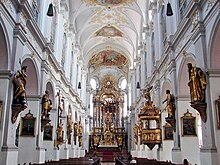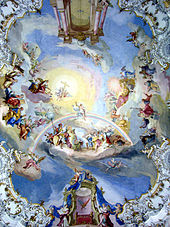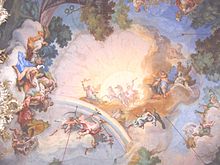Johann Baptist Zimmermann
Johann Baptist Zimmermann (born January 3, 1680 in Gaispoint , today Wessobrunn , † March 2, 1758 in Munich ) was a German painter and plasterer of the Baroque and Rococo periods .
origin
His parents were the plasterer Elias Zimmermann (* June 20, 1656 in Gaispoint; † around 1696) and Justina Zimmermann née Rohrmoser (*?; † October 20, 1717 in Wessobrunn).
Like his younger brother Dominikus Zimmermann , with whom he frequently worked, Johann Baptist Zimmermann is assigned to the Wessobrunn School . On March 28, 1705 he married Elisabeth Ostermayr, who was in the service of Countess Maxlrain, and in 1707 settled in Maxlrain'schen Markt Miesbach , where his five children were born and baptized, including his sons and close collaborators Johann Joseph and Franz Michael.
In 1715 he settled in the prince-bishop's residence town of Freising , from where he mainly worked for the Ottobeuren monastery. There he made the acquaintance of the Venetian Jacopo Amigoni , who in 1719 painted his first ceiling picture for this monastery church. Probably through his mediation the attention of the court architect Joseph Effner was drawn to Zimmermann. He probably won his first order for the Munich court with the stuccoing of the stairwell of Schleissheim Palace . He moved there around 1720, was appointed court plasterer with court protection in 1729 and also became the preferred plasterer of the Bavarian nobility. In 1732 he created frescoes for the prince-bishop in the Würzburg Neumünster Church in the Würzburg monastery and in 1724 the painting Johannes auf Patmos for the main altar there .
Honors
Johann-Baptist-Zimmermann-Streets exist in Grafing near Munich , Miesbach , Schäftlarn and Weyarn . There is also a Brüder-Zimmermann-Straße in Steingaden , near the Wieskirche , which honors him together with his brother Dominikus.
Works

(+ DZ) documents works on which his brother Dominikus Zimmermann also worked.
- 1701: Stucco and frescoes in the chancel of the parish church of the Visitation of the Virgin Mary in Gosseltshausen ( Wolnzach )
- 1707: Stucco and frescoes in the chancel and stucco in the nave and in the sacristy of the pilgrimage church Maria Schnee (Markt Rettenbach)
- before 1710 and 1728: Stucco in the monastery refectory of the Benedictine Abbey Kloster Tegernsee
- 1709 / 10–1713 / 27: frescoes in the monastery church of St. Maria as well as stucco and frescoes in the library of the former Reich Charterhouse in Buxheim (+ double room)
- 1711–1713: Stucco and frescoes in the Maria Saal monastery church and frescoes in the chapter house there
- 1714: Stucco and frescoes in the parish church of St. Sixtus in Schliersee
- 1714–1722: Stucco in the free imperial abbey of Ottobeuren
- before / around 1715 stucco and frescoes in three rooms in Maxlrain Castle
- (from) 1716: Stucco and frescoes in the cathedral cloister and in the side aisles of the Benediktuskirche in Freising
- 1717: Stucco and frescoes in the chapel and in the dining room of the former summer palace of the Prince-Bishop of Freising in Ismaning
- 1718–1722: Decorations of the Maria Medingen monastery church (Assumption of Mary) in Mödingen (+ double room)
- 1718–1723: Complete stucco work and twelve stucco sculptures of the apostles in the Jesuit college church of St. Georg in Amberg
- 1720–1726: Stucco in the stairwell in Schleißheim Palace under Joseph Effner
- around 1721: Stuccoing of the parish church of St. Peter in Munich
- 1720–1726 / 27: Stucco in the summer room and in the hall of mirrors of the first northern pavilion of Nymphenburg Palace
- 1722/23: decorations in the Dominican convent church of Maria, Queen of Angels , in Bad Wörishofen (+ double room)
- 1724: Johannes auf Patmos , altarpiece of the main altar in the Würzburg Neumünster .
- 1724 and 1731–1733: Stucco and frescoes in the former library, the ballroom and other rooms in the Benedictine monastery Benediktbeuern
- 1725 / 26–1727 / 29: Design and stucco of the parish church of St. Peter and Paul in Buxheim
- 1725 / 27–1728 / 33: Decorations in the Dominican convent church St. Markus in Sießen near Saulgau (+ double room)
- 1726–1733: Stucco in rooms in the Munich Residence
- 1727–1733: Design of the parish church of St. Peter and Paul and the pilgrimage church of UL Frau Steinhausen
- 1727 / 30–1731 / 33: Frescoes in the pilgrimage church of Our Lady of Sorrows in Steinhausen (+ DZ; is considered to be one of the main works)
- 1729: Stucco and frescoes of the former Augustinian Canons' Church of St. Peter and Paul Weyarn
- 1729 / 41–1741 / 48: Stucco and frescoes in the former collegiate church of the Assumption of the Virgin of the monastery in Dietramszell
- 1730: Stucco and frescoes in the former Augustinian canons monastery church of St. Johann Baptist in Beyharting
- around 1730: Stucco in the Maxlrain castle chapel
- around 1730: Stucco in the main hall of Wallenburg Castle near Miesbach
- 1730–1739: Stucco in the rich rooms of the Munich residence
- 1732: frescoes in the former collegiate church Neumünster in Würzburg (largely destroyed in 1945, largely copied after 1945)
- 1733/34: Design of the church of the Cistercian convent Seligenthal in Landshut
- 1733 / 54–1756 / 60: Stucco and frescoes in the former Premonstratensian monastery church of St. Dionys and Juliana in Schäftlarn
- 1734–1737 / 39: Stucco in the Amalienburg in Munich-Nymphenburg
- 1738–1740: Design of the parish church of the Assumption of Mary in Prien am Chiemsee
- 1736: ceiling fresco Augustinerkirche Ingolstadt (destroyed)
- 1737 / 43–1744 / 52: Stucco and frescoes in the cologne court church (current parish church) St. Michael in Berg am Laim
- 1738: Kern patrician house in Wasserburg am Inn
- 1745–1752: Design and stucco of the monastery church of the Assumption in Ettal
- 1747 / 49–1752: Baroque transformation of the former Dominican Church of St. Blasius in Landshut (stucco, frescoes and high altar sheet of St. Dominic as the patron saint of the city of Landshut )
- 1748 / 52–1752 / 54: Stucco and frescoes of the pilgrimage church " Maria Brünnlein zum Solst" near Wemding
- 1749 and 1753–1754: frescoes in the pilgrimage church of the Scourged Savior in Wies ( Wieskirche ); (+ DZ; counts as J. B's main work)
- 1751–1752 / 54: Stucco and frescoes in the monastery church of Andechs St. Nikolaus and St. Elisabeth
- 1751–1761: The pilgrimage church St. Anna in Munich-Harlaching is given a Baroque style
- 1753/54: Stucco and frescoes in the parish church of St. Peter in Munich
- 1755 / 56–1757: Stucco and frescoes in the Stone Hall in Nymphenburg Palace in Munich
- 1756: Frescoes in the former Premonstratensian monastery church in Neustift near Freising
- 1757: Frescoes and stucco in the parish church of St. Vitus in Abensberg - Offenstetten
literature
- Hermann Bauer, Anna Bauer: Johann Baptist and Dominikus Zimmermann. Origin and completion of the Bavarian Rococo . Pustet, Regensburg 1985, ISBN 3-7917-0918-6 .
- Harriet Brinkmöller-Gandlau: Johann Baptist Zimmermann. In: Biographisch-Bibliographisches Kirchenlexikon (BBKL). Volume 14, Bautz, Herzberg 1998, ISBN 3-88309-073-5 , Sp. 494-497.
- Stefan Kummer : Architecture and fine arts from the beginnings of the Renaissance to the end of the Baroque. In: Ulrich Wagner (Hrsg.): History of the city of Würzburg. 4 volumes; Volume 2: From the Peasants' War in 1525 to the transition to the Kingdom of Bavaria in 1814. Theiss, Stuttgart 2004, ISBN 3-8062-1477-8 , pp. 576–678 and 942–952, here: pp. 658 and 662.
- Sixtus Lampl : Johann Baptist Zimmermann (1680–1758): pioneer of the Bavarian Rococo. In addition, CD recordings with unknown music of the time. Schlossverlag, Valley 2008, ISBN 3-932055-05-5 .
- Christina Thon: Johann Baptist Zimmermann as stucco . Schnell & Steiner, Munich / Zurich 1977, ISBN 3-7954-0406-1 .
Web links
- Literature by and about Johann Baptist Zimmermann in the catalog of the German National Library
Individual evidence
- ↑ Stefan Kummer: Architecture and fine arts from the beginnings of the Renaissance to the end of the Baroque. 2004, p. 658.
- ↑ Stefan Kummer: Architecture and fine arts from the beginnings of the Renaissance to the end of the Baroque. 2004, p. 658.
| personal data | |
|---|---|
| SURNAME | Carpenter, Johann Baptist |
| BRIEF DESCRIPTION | German painter and plasterer of the Baroque era |
| DATE OF BIRTH | January 3, 1680 |
| PLACE OF BIRTH | Gaispoint near Wessobrunn |
| DATE OF DEATH | March 2, 1758 |
| Place of death | Munich |




